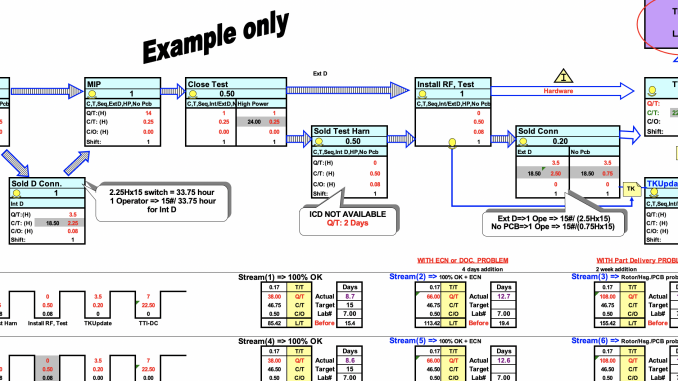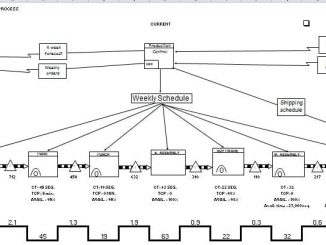
Since this post appeared more than four years ago, the Value Stream Map continues to be read and the templates continue (there are three templates by the way, see links below) to be downloaded on an almost daily basis. In the past four years, much as happened with regards to the manufacturing sector and the appearance of an increasing amount of contract manufacturers (CMs).
The VSM can be a crucial tool for new start-ups as a way of introducing Lean to its operations, from prototyping, to NPI (New Product Introduction), to MR (Mass Run).
After trying to devise my own VSM, I decided this was too tough of a task for a rainy Sunday morning so I went through my collection of VSM tools and decided to upload as is. I am not sure who the original author of this tool is so if you can point it out and let me know, I will gladly publish it. Otherwise, I take no credit for this value stream mapping template.
Hope you enjoy it! I will be posting two other VSM posts over the next few days so you can choose from three of the best Value Stream Mapping tools I have seen on the Internet.
Value Stream Map
What is a Value Stream Map or VSM? It is a visual process map that shows the flow and activity of a process, broken down by each step and whether the step is value added or non-value added. You might think if there is no value add to a step why is it there? Sounds counter intuitive to basic Lean principles doesn’t it?
Let’s keep it simple. The Value Stream Map helps identify opportunities for removing waste from a process. In some complex processes some steps will be identified as non-value add, but necessary. For example, if a management team decides to fund a ERP upgrade project, it would be best to have a general overview of the company’s needs before calling in consultants. A steering committee may have identified that an upgraded ERP system may only reap the full benefits in two years, after an anticipated acquisition. The upgraded ERP system may be already in use by the acquirer and process-mapping may be needed to optimize the best use of it. But I digress.
Let’s get back to the Value Stream Map. I feel that before any Value Stream Map team process mapping begins, that a SIPOC be already made available. The VSM is a more detailed SIPOC, in a somewhat flowchart form, using colors to identify value add, non-value add, and business or customer value-add steps.Let’s take the example of a complex process such as an airline reservation example.
The VSM should also include cycle times (or the times between each process step), what is the expected yield of defects from each step.3
The Value Stream Map is usually seen on the manufacturing shop floor and is a crucial Lean tool for optimizing manufacturing efficiency but it can also be used for inter-company processes or any process where the output delivers an output to a customer, internal or external.
iSixSigma.com sums it up well with this definition.
Download “Value Stream Map (VSM) V2 for Microsoft Excel” Value-Stream-Map-for-Microsoft-Excel-Version-2.xls – Downloaded 3947 times – 337.50 KB



Be the first to comment